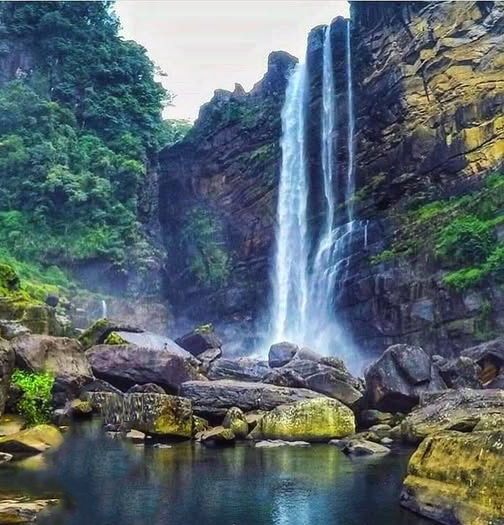

Laxapana Falls
Laxapana Falls, one of Sri Lanka’s most breathtaking waterfalls, is a marvel of nature nestled in the heart of the Central Highlands. With its impressive height and dramatic setting, this waterfall is a favorite destination for adventurers, photographers, and nature enthusiasts alike.
Location and Accessibility
Laxapana Falls is situated in the Maskeliya area of the Nuwara Eliya district, approximately 125 kilometers from Colombo and about 20 kilometers from the town of Hatton. The waterfall is easily accessible via the Hatton-Maskeliya road, with clear signage guiding visitors to the site. A short hike through scenic tea plantations and forested paths leads to the base of the falls, offering stunning views along the way.
The Beauty of Laxapana Falls
Standing at an impressive height of 126 meters, Laxapana Falls is the eighth-highest waterfall in Sri Lanka. The cascade is fed by the Maskeliya Oya, a tributary of the Kelani River, which originates from the lush hills of the Central Highlands. The water plunges dramatically over a rocky cliff, creating a misty veil and a symphony of roaring sounds that captivate visitors.
Surrounded by verdant greenery and tea estates, the waterfall’s natural setting is as enchanting as the falls themselves. The area offers panoramic views of the surrounding hills, making it a serene retreat for those looking to escape the hustle and bustle of city life.
Historical and Cultural Significance
Laxapana Falls holds a special place in Sri Lanka’s history and folklore. It is believed to be the location where Lord Buddha mended his robe during one of his visits to the island. The name “Laxapana” is said to derive from the Sinhalese words “Lakshapana,” meaning “a hundred thousand rocks,” reflecting the rugged terrain surrounding the waterfall.
Activities and Attractions
Visitors to Laxapana Falls can enjoy a variety of activities, including:
Hiking: The trails leading to the falls are ideal for nature walks and hikes, offering spectacular views of tea plantations and lush forests.
Photography: The waterfall’s dramatic drop and picturesque surroundings make it a paradise for photographers.
Swimming: The pool at the base of the falls provides an opportunity for a refreshing dip, though caution is advised due to strong currents during the rainy season.
In addition to the waterfall itself, the nearby Laxapana Dam and power station are notable attractions, highlighting the area’s importance in Sri Lanka’s hydropower generation.
Best Time to Visit
The best time to visit Laxapana Falls is during the monsoon season (April to November), when the water flow is at its peak. However, visitors should be mindful of slippery trails and strong currents during heavy rains. Early mornings and late afternoons are ideal for enjoying the falls in a tranquil atmosphere.
Environmental Importance
Laxapana Falls plays a crucial role in the local ecosystem and serves as a source of water for nearby villages. It is also integral to Sri Lanka’s hydroelectric power generation, contributing to the country’s renewable energy efforts. Preserving the natural beauty and ecological balance of the area is vital to sustaining its charm and functionality.



